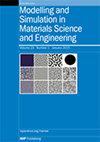弹性各向异性对hcp金属塑性的作用:三维位错动力学研究
IF 2.4
4区 材料科学
Q3 MATERIALS SCIENCE, MULTIDISCIPLINARY
Modelling and Simulation in Materials Science and Engineering
Pub Date : 2010-10-12
DOI:10.1088/0965-0393/18/8/085002
引用次数: 32
摘要
采用三维离散位错动力学方法研究了长程和短程相互作用对六方密排金属早期应力-应变响应和位错密度演化的影响。为了检查远程相互作用,DD代码的开发使得相互作用位错之间的弹性应力场通过强制弹性各向同性或考虑hcp金属的实际弹性各向异性常数来计算。为了改进对短程相互作用的处理,实现了一套密切相互作用位错行为的局部规则。特别是,提出了一种新的排斥性短程相互作用时的弹性排斥力方案,并发现该方案对应力-应变响应和位错密度演化有显著影响。对三种hcp单晶(Hf, Mg和Zr)在c轴张力下进行了大规模模拟,研究了弹性各向异性对几种相互作用位错集体响应的影响。发现偏离各向同性弹性对应变硬化有很大影响,特别是对Hf。本文章由计算机程序翻译,如有差异,请以英文原文为准。
The role of elastic anisotropy on plasticity in hcp metals: a three-dimensional dislocation dynamics study
The effects of long-range and short-range interactions on the early stress–strain response and dislocation density evolution in hexagonal close-packed (hcp) metals are studied using three-dimensional discrete dislocation dynamics (DD). To examine long-range interactions, the DD code is developed such that elastic stress fields between interacting dislocations are calculated by either enforcing elastic isotropy or considering the actual elastic anisotropic constants of the hcp metal. To improve treatment of short-range interactions, a set of local rules for the behavior of closely interacting dislocations is implemented. In particular, a new scheme for elastic repulsion in the event of repulsive short-range interactions is presented and found to have a significant effect on the stress–strain response and dislocation density evolution. Large-scale simulations are performed for three hcp single crystals (Hf, Mg and Zr) in c-axis tension to examine the effect of elastic anisotropy on the collective response of several interacting dislocations. It is found that departure from isotropic elasticity has a substantial effect on strain hardening, particularly for Hf.
求助全文
通过发布文献求助,成功后即可免费获取论文全文。
去求助
来源期刊
CiteScore
3.30
自引率
5.60%
发文量
96
审稿时长
1.7 months
期刊介绍:
Serving the multidisciplinary materials community, the journal aims to publish new research work that advances the understanding and prediction of material behaviour at scales from atomistic to macroscopic through modelling and simulation.
Subject coverage:
Modelling and/or simulation across materials science that emphasizes fundamental materials issues advancing the understanding and prediction of material behaviour. Interdisciplinary research that tackles challenging and complex materials problems where the governing phenomena may span different scales of materials behaviour, with an emphasis on the development of quantitative approaches to explain and predict experimental observations. Material processing that advances the fundamental materials science and engineering underpinning the connection between processing and properties. Covering all classes of materials, and mechanical, microstructural, electronic, chemical, biological, and optical properties.

 求助内容:
求助内容: 应助结果提醒方式:
应助结果提醒方式:


